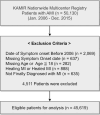Long-term air pollution exposure is associated with higher incidence of ST-elevation myocardial infarction and in-hospital cardiogenic shock
- PMID: 38424210
- PMCID: PMC10904831
- DOI: 10.1038/s41598-024-55682-6
Long-term air pollution exposure is associated with higher incidence of ST-elevation myocardial infarction and in-hospital cardiogenic shock
Abstract
Previous studies have reported the association between myocardial infarction (MI) and air pollution (AP). However, limited information is available regarding the long-term effects of AP on the relative incidence rates of ST-elevation MI (STEMI) and Non-ST-elevation MI (NSTEMI). We investigated the association between long-term exposure to AP and the incidence of STEMI. Between January 2006 and December 2015, a total of 45,619 eligible patients with Acute Myocardial Infarction (AMI) were enrolled in the Korea Acute MI Registry (KAMIR) and KAMIR-National Institutes of Health. Mixed-effect regression models were used to examine the association between the annual average ambient AP before MI onset and the incidence of STEMI, and to evaluate the association of AP with the incidence of in-hospital cardiogenic shock. After mixed-effect regression model analysis, particulate matter (PM) 10 µm or less in diameter (PM10) was associated with increased incidence of STEMI compared with NSTEMI (odds ratio [OR] 1.009, 95% Confidence Interval [CI] 1.002-1.016; p = 0.012). For in-hospital cardiogenic shock complication, PM10 and SO2 were associated with increased risk, PM10 (OR 1.033, 95% CI 1.018-1.050; p < 0.001), SO2 (OR 1.104, 95% CI 1.006-1.212; p = 0.037), respectively. Policy-level strategies and clinical efforts to reduce AP exposure are necessary to prevent the incidence of STEMI and severe cardiovascular complications.
© 2024. The Author(s).
Conflict of interest statement
The authors declare no competing interests.
Figures


References
-
- World Health Organization. Regional Office for the Western, P. Health at a glance: Asia/Pacific 2014: Measuring progress towards universal health coverage. 115 p. (OECD Publishing, 2014).
MeSH terms
Substances
Grants and funding
LinkOut - more resources
Full Text Sources
Medical

